Like silent guardians of indoor spaces, snake plants have become the go-to choice for plant enthusiasts seeking rapid growth and minimal maintenance. You’ll find these hardy specimens transforming from modest sprouts to impressive vertical statements in a matter of months, with some varieties growing up to 4 inches monthly. If you’re ready to discover which snake plant varieties can turn your space into a thriving indoor jungle the fastest, these top performers won’t disappoint.

Contents
1. Moonshine Snake Plant

The Moonshine Snake Plant (Sansevieria trifasciata ‘Moonshine’) is a striking variety of snake plant featuring broad, silvery-gray leaves with subtle green undertones. This cultivar grows in an upright, architectural form reaching heights of 2-3 feet tall. Its pale, ethereal coloring makes it a standout choice for modern interior spaces, and like other snake plants, it’s known for its air-purifying qualities and remarkable resilience.
- Light: Tolerates low light but thrives in bright, indirect light; avoid direct sunlight which can fade the silvery coloring
- Water: Allow soil to dry between waterings; water less frequently in winter; susceptible to root rot if overwatered
- Soil: Well-draining potting mix; preferably a cactus or succulent blend
- Temperature: Comfortable in average room temperatures between 60-85°F (15-29°C)
- Humidity: Adapts to most indoor humidity levels; no special requirements
- Fertilizer: Light feeding with balanced fertilizer during growing season (spring and summer)
- Container: Pot with drainage holes; can be slightly root-bound
2. Futura Superba Snake Plant
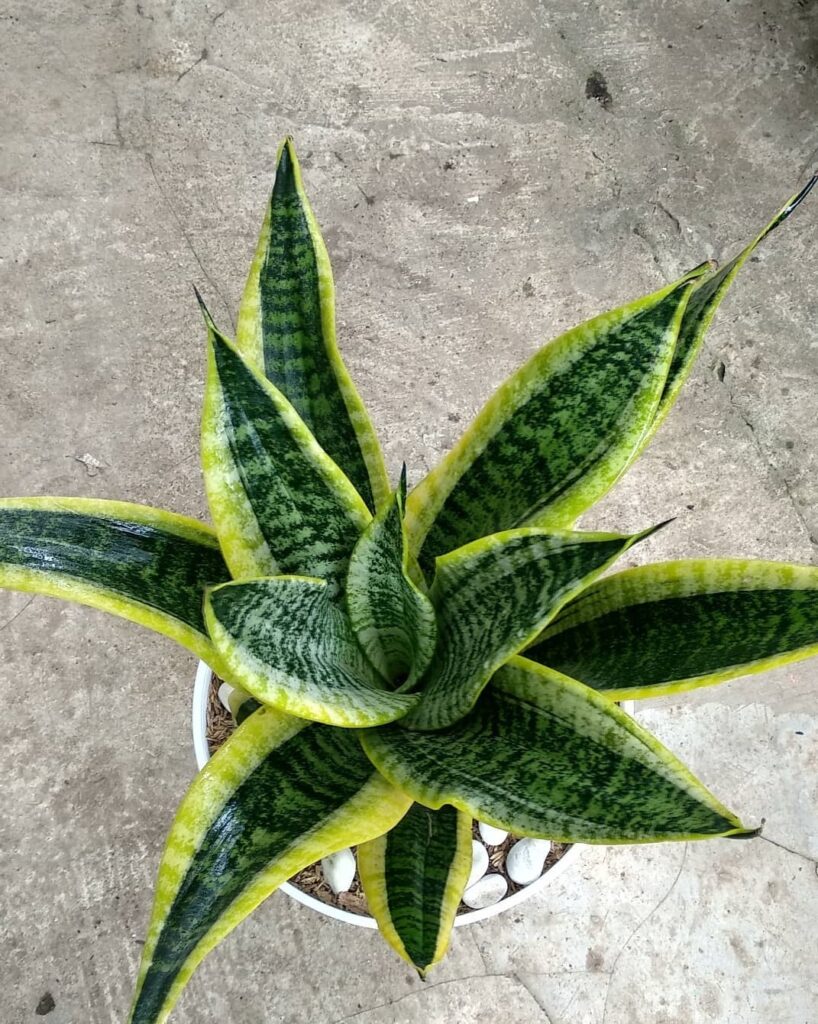
The Futura Superba Snake Plant (Sansevieria trifasciata ‘Futura Superba’) is a compact variety of snake plant featuring striking dark green leaves with light gray-green horizontal bands. This dwarf cultivar typically grows to about 12-15 inches tall, making it perfect for small spaces and tabletop displays. The leaves are stiff, upright, and arranged in a rosette pattern, maintaining the classic sword-like shape characteristic of snake plants but in a more condensed form.
- Light: Tolerates low light but thrives in bright, indirect sunlight; avoid direct sun exposure
- Water: Allow soil to dry between waterings; water sparingly during winter months
- Soil: Well-draining potting mix; preferably succulent or cactus soil
- Temperature: 60-85°F (15-29°C)
- Humidity: Adaptable to various humidity levels; tolerates dry air
- Fertilizer: Light feeding with balanced fertilizer during growing season
- Container: Pot with drainage holes; does well in slightly root-bound conditions
- Potting: Repot every 2-3 years or when rootbound
3. Laurentii Snake Plant
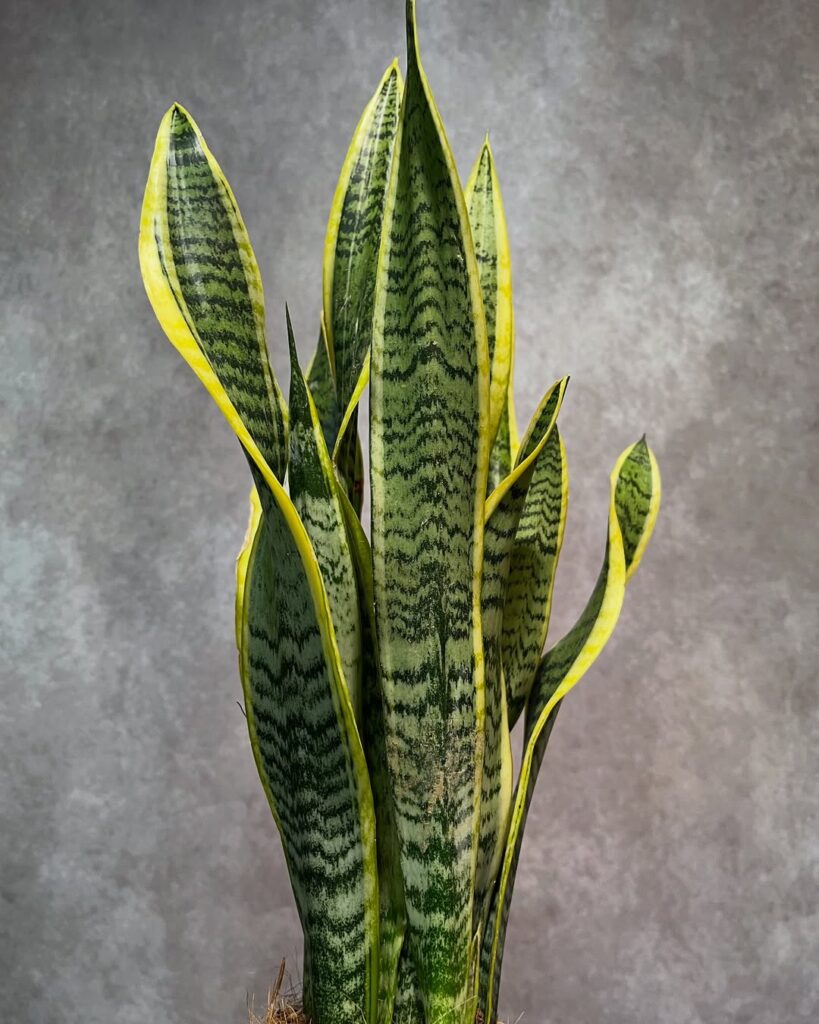
The Laurentii Snake Plant (Sansevieria trifasciata ‘Laurentii’) is a popular variegated variety of snake plant characterized by its striking yellow-gold edges along dark green sword-shaped leaves. This cultivar grows upright in a rosette pattern and can reach heights of 2-4 feet indoors. Its distinctive variegation and air-purifying qualities make it a sought-after houseplant, though it grows more slowly than its non-variegated counterparts.
- Light: Tolerates low light but thrives in bright, indirect light; avoid direct sunlight which can fade variegation
- Water: Allow soil to dry completely between waterings; water less in winter
- Soil: Well-draining potting mix; preferably succulent or cactus soil
- Temperature: 60-85°F (15-29°C)
- Humidity: Adaptable to any humidity level
- Fertilizer: Light feeding with balanced fertilizer during growing season
- Container: Pot with drainage holes; slightly root-bound conditions acceptable
- Propagation: Division of rhizomes or leaf cuttings (note: leaf cuttings will lose variegation)
4. Black Gold Snake Plant
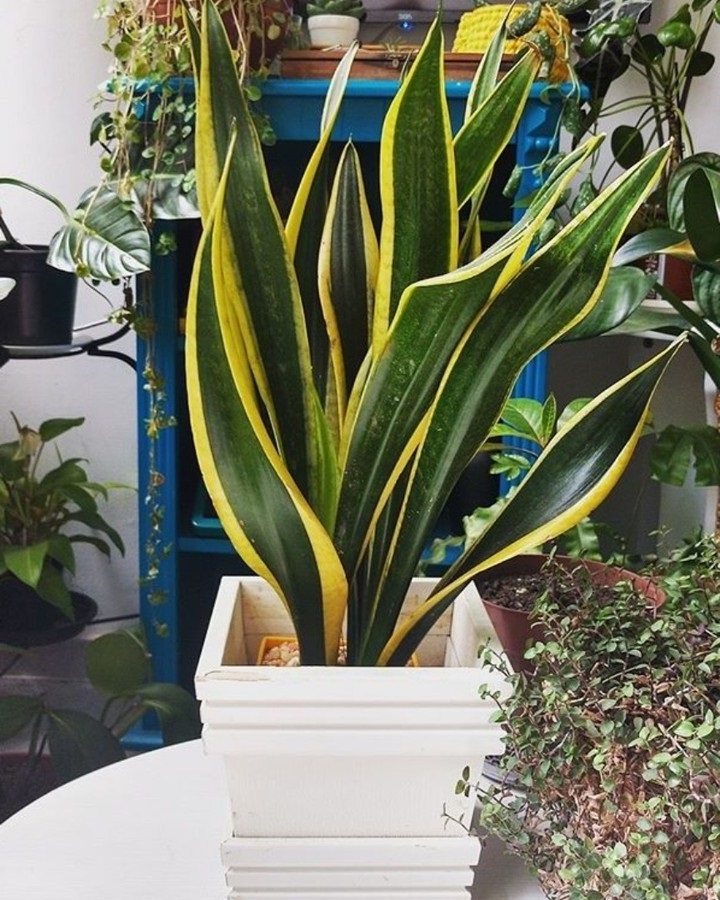
The Black Gold Snake Plant (Sansevieria trifasciata ‘Black Gold’) is a striking variant of the common snake plant, featuring dark green leaves with golden-yellow edges. This cultivar grows in an upright pattern with sword-like leaves that can reach heights of 2-3 feet tall. Its distinctive coloring and architectural form make it a popular choice for modern interior spaces, while maintaining the same hardy nature and air-purifying qualities as other snake plant varieties.
- Light: Tolerates low light but thrives in bright, indirect sunlight; avoid direct sun which can fade variegation
- Water: Allow soil to dry between waterings; water sparingly during winter months
- Soil: Well-draining potting mix; prefers slightly sandy soil
- Temperature: 60-85°F (15-29°C)
- Humidity: Adaptable to various humidity levels; thrives in average home conditions
- Fertilizer: Light feeding with balanced fertilizer during growing season (spring/summer)
- Pot Requirements: Container with drainage holes; prefers to be slightly root-bound
5. Starfish Snake Plant
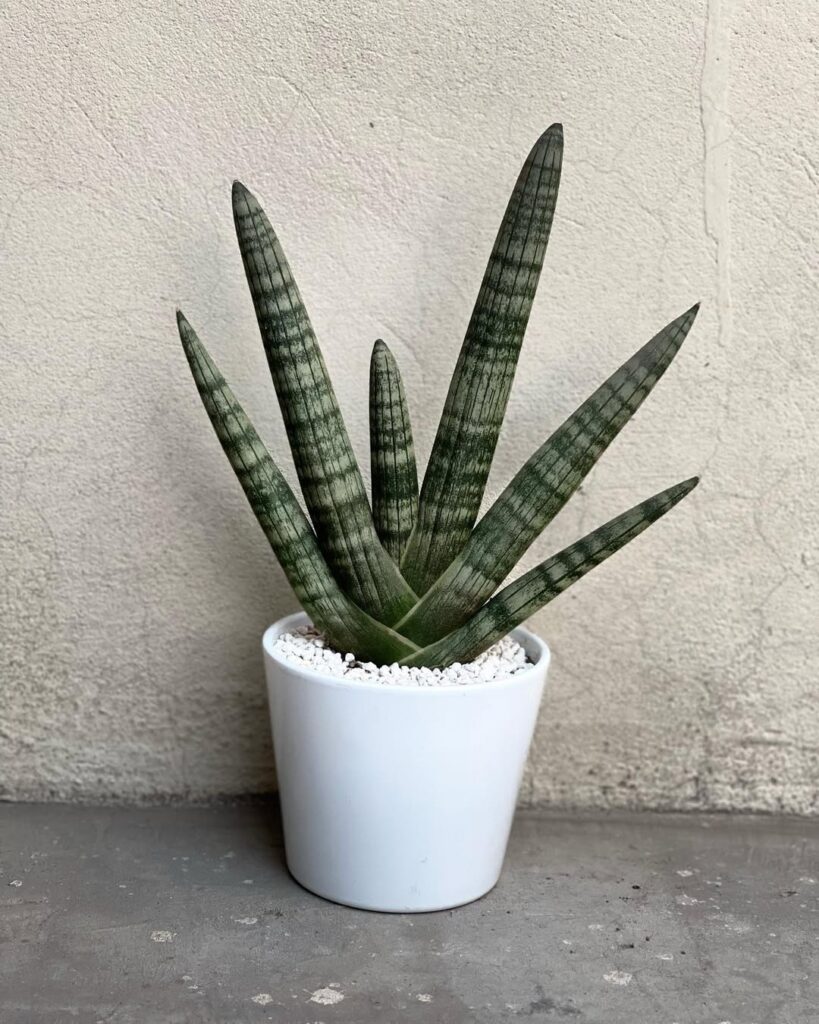
The Starfish Snake Plant (Sansevieria cylindrica ‘Boncel’) is a distinctive variety characterized by its cylindrical, spike-like leaves that grow in a fan pattern from a central base, resembling a starfish. These succulent leaves are thick, round, and typically grow to 1-2 feet tall, featuring dark green coloring with subtle horizontal bands. Unlike its flat-leaved cousins, this variety’s cylindrical leaves give it a modern, sculptural appearance that makes it an attractive choice for contemporary interior spaces.
- Light: Thrives in bright indirect light but tolerates low light; can handle some direct sun
- Water: Allow soil to dry completely between waterings; water sparingly in winter
- Soil: Well-draining succulent or cactus mix
- Temperature: Comfortable in normal room temperatures between 60-85°F (15-29°C)
- Humidity: Adapts to any humidity level; prefers average home humidity
- Container: Use pot with drainage holes to prevent root rot
- Fertilizer: Feed lightly with balanced fertilizer once or twice during growing season
6. Whitney Snake Plant
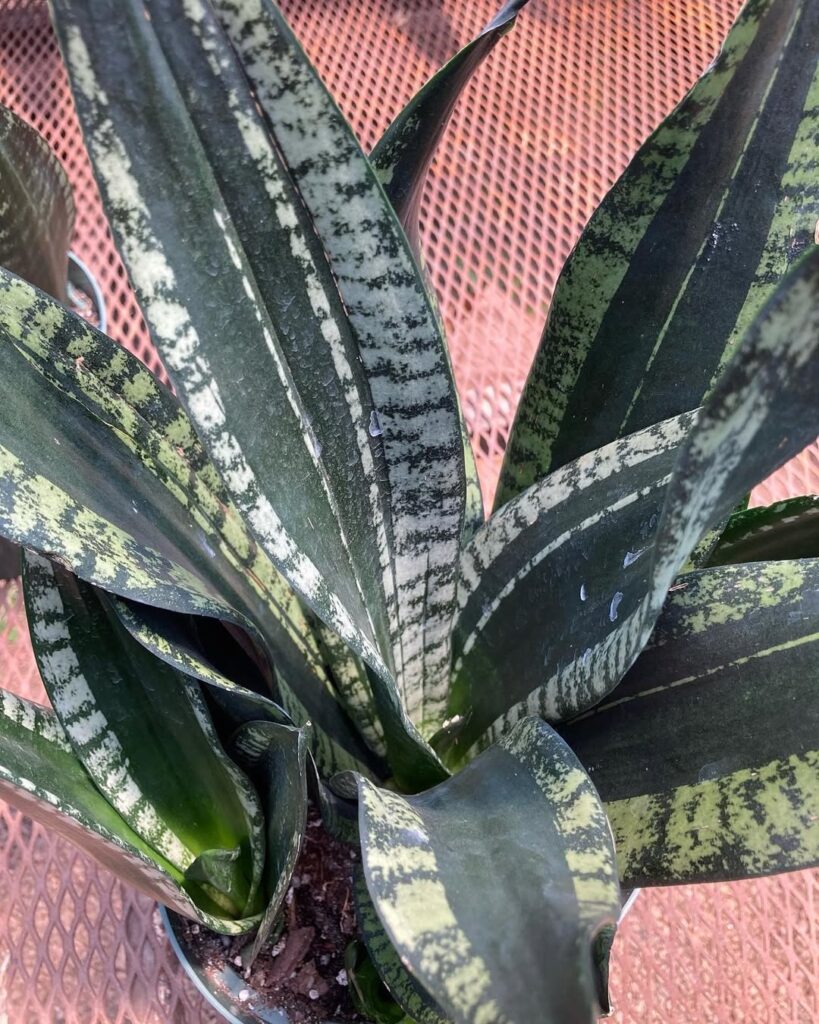
The Whitney Snake Plant (Sansevieria trifasciata ‘Whitney’) is a compact cultivar of the traditional snake plant, characterized by its shorter, wider leaves with distinctive white variegation along the leaf margins. This dwarf variety typically grows to about 6-12 inches tall, making it ideal for small spaces and windowsills. Its succulent leaves are arranged in a rosette pattern and maintain the signature upright growth habit of snake plants while displaying a more condensed form.
- Light: Tolerates low to bright indirect light; avoid direct sunlight which can scorch leaves
- Water: Allow soil to dry between waterings; water less frequently in winter
- Soil: Well-draining potting mix; preferably a cactus or succulent blend
- Temperature: Thrives in 60-85°F (15-29°C)
- Humidity: Adaptable to most indoor humidity levels
- Fertilizer: Light feeding with balanced fertilizer during growing season
- Container: Pot with drainage holes to prevent root rot
- Growing Medium pH: 6.0-7.5
7. Bantel’s Sensation Snake Plant
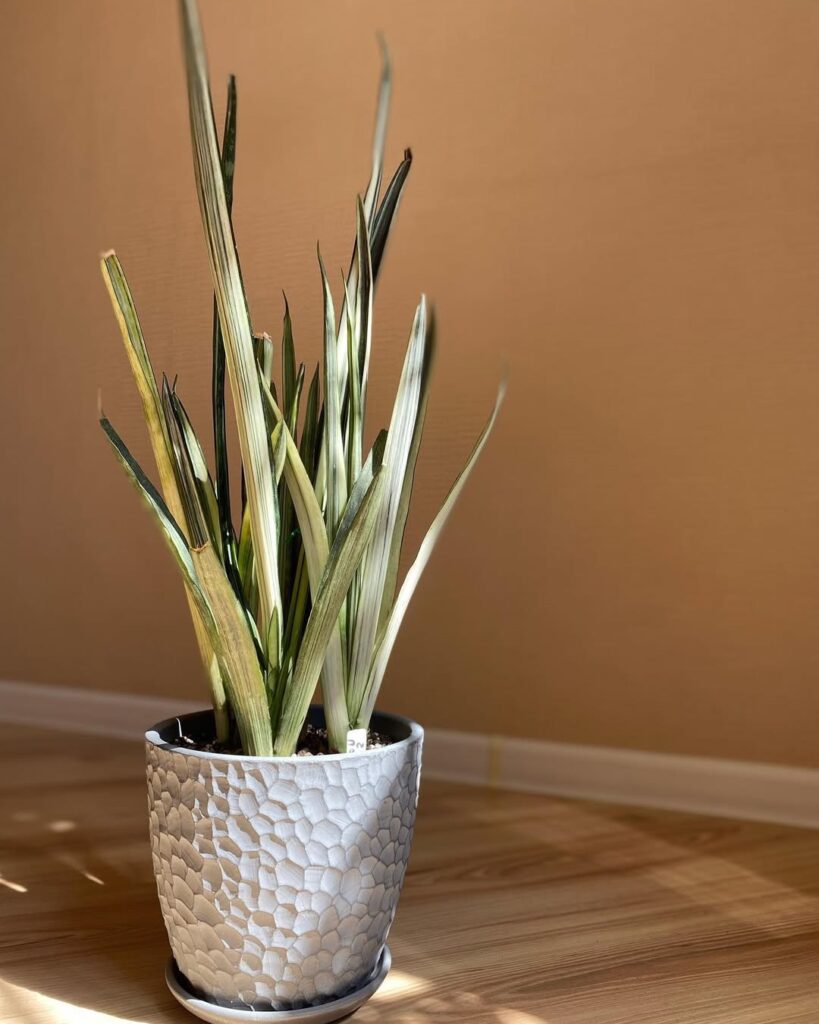
Bantel’s Sensation (Sansevieria trifasciata ‘Bantel’s Sensation’) is a striking variety of snake plant characterized by its narrow, upright leaves featuring distinctive white vertical stripes on a dark green background. This cultivar typically grows to about 2-3 feet tall and maintains a compact, elegant form. The leaves are thinner than those of common snake plant varieties, and their crisp white variegation makes them particularly attractive as decorative indoor specimens.
- Light: Tolerates low light but thrives in bright, indirect sunlight; avoid direct sun which can fade variegation
- Water: Allow soil to dry between waterings; water less frequently in winter
- Soil: Well-draining potting mix; preferably a cactus or succulent blend
- Temperature: 60-85°F (15-29°C)
- Humidity: Adaptable to various humidity levels; prefers average home humidity
- Fertilizer: Light feeding with balanced fertilizer during growing season
- Pot: Container with drainage holes to prevent root rot
- Growth Rate: Slow to moderate growth
8. Zeylanica Snake Plant
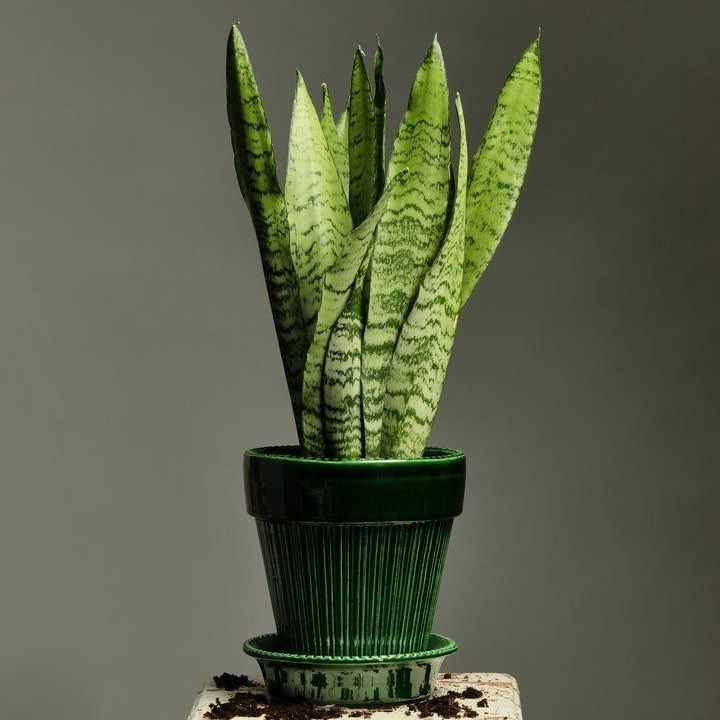
The Zeylanica Snake Plant (Sansevieria zeylanica) is a hardy succulent featuring stiff, upright leaves with distinctive dark green bands and subtle silver-gray horizontal striping. This variety typically grows between 2-3 feet tall and maintains a relatively narrow footprint, making it an excellent choice for smaller spaces. The leaves are more slender than other snake plant varieties, and they taper to a fine point at the tip, creating an elegant, architectural appearance that fits well in modern and traditional decor schemes.
- Light: Tolerates low light but thrives in bright, indirect light; can handle some direct morning sun
- Water: Allow soil to dry completely between waterings; water less in winter
- Soil: Well-draining potting mix; preferably cactus or succulent soil
- Temperature: 60-85°F (15-29°C)
- Humidity: Adaptable to most indoor humidity levels
- Fertilizer: Light feeding with balanced fertilizer during growing season
- Container: Pot with drainage holes; slightly root-bound conditions acceptable
9. Twisted Sister Snake Plant
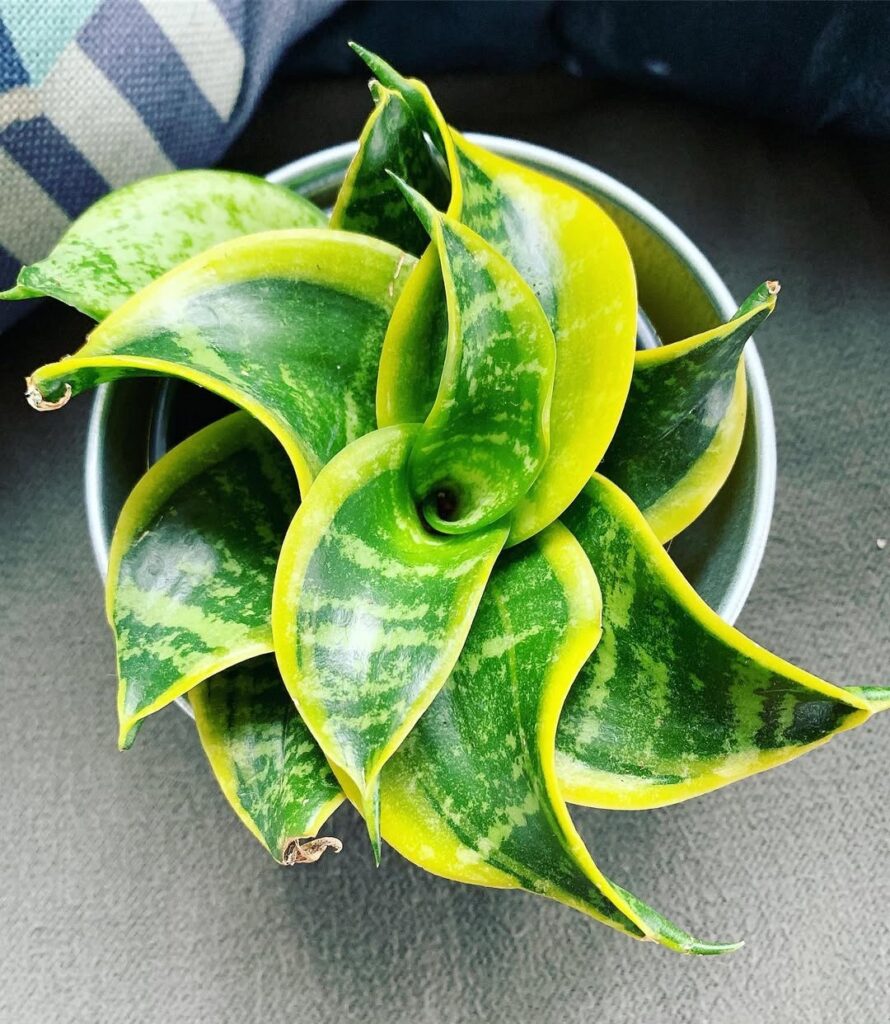
The Twisted Sister Snake Plant (Sansevieria trifasciata ‘Twisted Sister’) is a compact cultivar known for its distinctively curled and twisted leaves that grow in a spiraling pattern. This dwarf variety typically reaches heights of 12-15 inches, making it perfect for small spaces and tabletop displays. Its leaves feature the classic snake plant variegation with golden-yellow edges and dark green centers, but with a unique cork-screw appearance that sets it apart from other snake plant varieties.
- Light: Tolerates low light but thrives in bright, indirect light; avoid direct sunlight
- Water: Allow soil to dry between waterings; water less frequently in winter
- Soil: Well-draining potting mix; prefer slightly sandy, loose soil
- Temperature: 60-85°F (15-29°C)
- Humidity: Adaptable to most indoor humidity levels
- Fertilizer: Light feeding with balanced fertilizer during growing season
- Container: Pot with drainage holes; prefer to be slightly root-bound
- Growth Rate: Slow to moderate growth rate
- Propagation: Division of rhizomes or leaf cuttings in water or soil
10. Jaboa Grows Upright Rapidly

The Jaboa variety of snake plant (Sansevieria) is known for its distinctively fast vertical growth pattern, reaching heights of up to 4 feet in ideal conditions. This cultivar produces thick, sword-shaped leaves that grow straight upward with minimal spread, making it an excellent choice for narrow spaces or as a striking architectural element in interior design. Its rapid growth rate, compared to other snake plant varieties, allows it to quickly establish itself as a prominent indoor specimen.
- Light: Tolerates low light but grows fastest in bright, indirect sunlight; can handle some direct morning sun
- Water: Allow soil to dry between waterings; water every 2-3 weeks in growing season, less in winter
- Soil: Well-draining potting mix; preferably a cactus or succulent blend
- Temperature: Thrives in 70-90°F (21-32°C)
- Humidity: Adaptable to any humidity level
- Fertilizer: Light feeding with balanced fertilizer once per quarter during growing season
- Container: Deep pot with drainage holes to accommodate vertical root growth
- pH: 6.0-7.5
